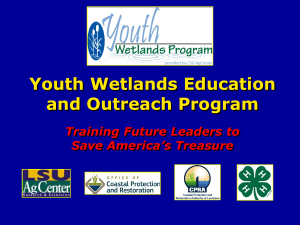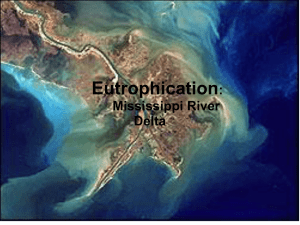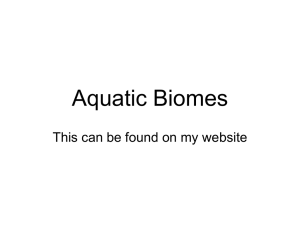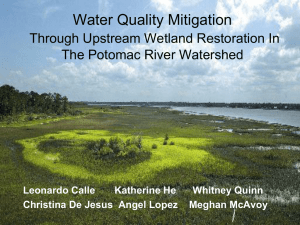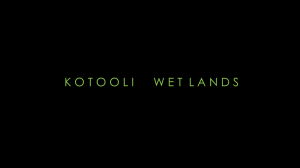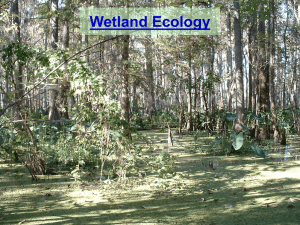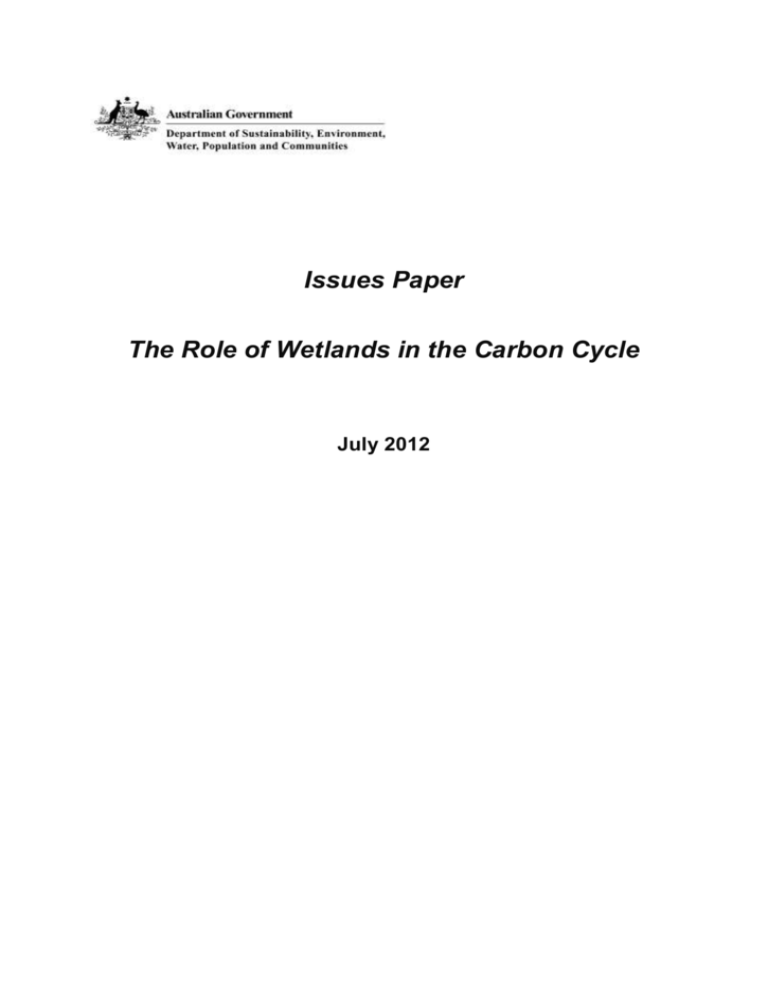
Issues Paper
The Role of Wetlands in the Carbon Cycle
July 2012
This issues paper was developed by the Department of Sustainability, Environment, Water,
Population and Communities in consultation with the Wetlands and Waterbirds Taskforce.
Wetlands and Waterbirds Taskforce
John Foster – Chair (Australian Government Department of Sustainability, Environment,
Water, Population and Communities), Lisa Evans (ACT Department of Territory and
Municipal Services), Alison Curtin (NSW Office of Environment and Heritage), Brydie Hill
(NT Department of Natural Resources, Environment, The Arts and Sport), Mike Ronan (Qld
Department of Environment and Heritage Protection), Paul Wainwright (SA Department of
Environment, Water and Natural Resources), Stewart Blackhall (Tas Department of Primary
Industries, Parks, Water and Environment), Janet Holmes (Vic Department of Sustainability
and Environment), Dr Michael Coote (WA Department of Environment and Conservation)
and Dr Colin O'Donnell (New Zealand Department of Conservation).
© Commonwealth of Australia 2012
This work is copyright. You may download, display, print and reproduce this material in unaltered form
only (retaining this notice) for your personal, non-commercial use or use within your organisation.
Apart from any use as permitted under the Copyright Act 1968, all other rights are reserved.
Requests and enquiries concerning reproduction and rights should be addressed to
Department of Sustainability, Environment, Water, Population and Communities, Public
Affairs, GPO Box 787 Canberra ACT 2601 or email public.affairs@environment.gov.au
i
Contents
Contents .................................................................................................................................................. ii
Summary .................................................................................................. Error! Bookmark not defined.
1.
Purpose ........................................................................................................................................... 1
2.
Introduction .................................................................................................................................... 1
3.
Wetlands and the carbon cycle....................................................................................................... 2
4.
Carbon sequestration in wetlands globally..................................................................................... 4
Carbon sequestration in various types of wetlands at a global scale ................................................. 5
Degradation of wetlands..................................................................................................................... 5
Potential of wetland types for carbon sequestration ......................................................................... 6
5.
Australian wetlands ........................................................................................................................ 7
6.
Impacts of climate change on wetland carbon cycles .................................................................... 8
7.
Synergies between biodiversity and climate change actions in wetlands...................................... 9
8.
International policies and programs ............................................................................................. 10
9.
Relevant Australian policies and programs................................................................................... 11
10.
Program design issues............................................................................................................... 13
11.
Conclusion ................................................................................................................................. 14
ii
Summary
Wetlands play an important role in landscape function, including cycling of
carbon, water and nutrients, food and fibre production, water purification,
regulation of flows, provision of habitats, and tourism and recreation
services.
The role of wetlands in carbon sequestration and storage has generally
been under-estimated. Wetlands cover approximately six to nine per cent
of the Earth’s surface and contain about 35 per cent of global terrestrial
carbon. As wetlands are centres of high productivity in the landscape, they
have a high capacity to sequester and store carbon. As depositional areas,
wetlands can also store carbon-rich organic sediments. However, under
anaerobic conditions, wetlands can also produce greenhouse gases such
as methane and nitrous oxide, though this is limited in saline conditions.
Clearing or drainage of wetlands can lead to large losses of stored organic
carbon to atmospheric carbon dioxide.
Greater consideration needs to be given to the roles of wetlands as carbon
sources, sinks and storages, when designing climate protection and natural
resource programs. Information on the functions of specific types of Australian
wetlands is required, to enable better evaluation of their contribution to climate
change mitigation and adaptation and to assist in design of programs for their
protection, enhancement and restoration for multiple benefits.
.
iii
1. Purpose
This paper considers the role of wetlands in carbon cycling, the implications of climate
change for wetland functions and services, and mechanisms to promote protection and
restoration of wetlands for multiple benefits including carbon sequestration.
2. Introduction
Wetlands play an important role in the landscape in Australia, including in the cycling of
water, carbon and nutrients. They provide ecosystem services including production of food
and fibre, water supply, water purification, regulation of water flows, coastal protection,
biodiversity, pollination, tourism and recreation. They are among Australia’s most productive
and biologically diverse ecosystems, and provide essential habitat for many kinds of
waterbirds, fish, amphibians, invertebrates and plants.1
There is increasing evidence, including through recent work by the Ramsar Convention’s
Scientific and Technical Review Panel (STRP), that wetlands have an important and underestimated role in both carbon storage and the regulation of greenhouse gas emissions.
Some types of wetlands play a particularly important role as carbon stores. These include
forested wetlands, temperate and tropical peatlands and vegetated inter-tidal wetlands
(including saltmarshes and mangroves).2 Degradation of wetlands is a significant source of
emissions of carbon dioxide to the atmosphere.
Consequently, it is worthwhile to consider the role of wetlands in carbon sequestration and
storage in Australia and the case for investment in protection and restoration of wetlands for
both carbon storage and other benefits.
1
Pritchard, D 2009, Reducing Emissions from Deforestation and Forest Degradation in developing countries
(REDD) - the link with wetlands, Foundation for International Environmental Law and Development, viewed 28
February 2012 http://www.irthebest.com?REDD-wetland.html, p. 6.
2
Danone Fund for Nature, Achieving carbon offsets through mangroves and other wetlands, November 2009
expert workshop report, Danone Group/IUCN/RamsarConvention, Gland, Switzerland, p. 6.
1
3. Wetlands and the carbon cycle
Wetlands play an important role in regulating exchanges of greenhouse gases to and from
the atmosphere, including water vapour, carbon dioxide, methane, nitrous oxide and sulfur
dioxide. They tend to be sinks for carbon and nitrogen and sources for methane and sulfur
compounds, but situations vary from place to place, time to time and between wetland
types.3 See Figure 1.
Figure 1: Carbon cycle in wetlands4
All wetlands are capable of sequestering and storing carbon through photosynthesis and
accumulation of organic matter in soils, sediments and plant biomass. While recognising the
complex processes that occur in wetlands, in general wetland plants grow at a faster rate
than they decompose, contributing to a net annual carbon sink.
Waterlogging of wetland soils limits oxygen diffusion into sediment profiles creating
anaerobic conditions. These conditions also slow decomposition rates, leading to the buildup and storage of large amounts of organic carbon in wetland sediments.
However, anaerobic conditions are conducive to the production of greenhouse gases such
as methane (CH4) and nitrous oxide (N2O). In periodically inundated systems, such as those
on floodplains, methane emissions can be highly variable. When the wetlands are inundated
and anaerobic conditions exist, methane may be produced. When these wetlands are dry,
they may act as methane sinks. Salinity also inhibits production of methane, so coastal
wetlands may have lower methane emission rates than freshwater wetlands. Production of
nitrous oxide in undisturbed wetlands is generally low compared with terrestrial soil
environments. 5
3
Pritchard, Reducing Emissions from Deforestation and Forest Degradation in developing countries, p. 7.
Kayranli, B, Scholz, M, Mustafa, A and Hedmark, A 2012. Carbon storage and fluxes within freshwater
wetlands: A critical review. Wetlands 30 pp 111-124.
5
Page and Dalal, Contribution of natural and drained wetland systems, pp. 378-379.
4
2
Wetlands are also involved in horizontal transport of carbon between ecosystems. Wetlands
can trap carbon-rich sediments from catchments, but may also disperse carbon through
water flow into floodplains. In Australia, carbon can accumulate on floodplains and is
redistributed by flood events and concentrated adjacent to river channels, wetlands and
floodplains as floodwaters recede (the bath-ring effect). This promotes productivity and
biomass growth in these areas. Reductions to flows that inundate in-channel bench surfaces
have affected the health of river red gums growing on the high-level benches, and have also
potentially reduced the supply of leaf litter and organic matter transported into the main
channel system.6
The hydrological connections between watercourses and their associated floodplains are
important for the exchange of carbon and nutrients7. The connections are considered
essential for the functioning and integrity of floodplain-river systems.
Drainage and subsequent oxidation of wetland soils can both decrease methane production
and lead to large net losses of sediment organic carbon. However, while decreases in
methane production may occur from drained wetland sediments, drainage channels may be
net emitters of methane.
Wetlands may therefore be either sources or sinks of carbon, depending on their type, and
can switch between being sinks of carbon to becoming net sources. This switching can be a
natural process due to seasonal or other factors or can be affected by human management.
Negative feedback mechanisms due to climate change may undermine the sequestration
potential of wetlands, for example, by increasing the incidence and severity of fires and
droughts.8
The role of wetlands in the global carbon cycle requires further research, particularly on
different wetland types and their function as both sources and sinks of greenhouse gases.9
6
Murray-Darling Basin Authority 2012, Assessment of environmental water requirements for the proposed
Basin Plan: Lower Darling River System, MBBA, Canberra, p. 6
7
Thoms, M 2003 Floodplain-river ecosystems: lateral connections and the implications of human interference.
Geomorphology, Vol. 56: pp. 335–349.
8
Dudley, N, Stolton, S, Belokurov, A, Krueger, L, Lopoukhine, N, McaKinnon, K, Sandwith, T, & Kekhran, N (eds)
2010, Natural Solutions: Protected areas helping people cope with climate change, A report funded and
commissioned by IUCN-WCPA, TNC, UNDP, WCS, The World Bank and WWF, Gland, Sitzerland, Washington
DC, and New York, USA, p. 36.
9
CBD Secretariat/Ramsar Secretariat/Ramsar Scientific and Technical Review Panel (STRP) 2007, Water,
wetlands, biodiversity and climate change, Provisional outcomes of an expert meeting, 23-24 March 2007,
Gland, Switzerland, viewed 24 February 2012 <www.ramsar.org/pdf/sc/36/key_sc36_doc12.pdf>, p. 96.
3
4. Carbon sequestration in wetlands globally
Wetlands are critical to mitigating climate change through capture and storage of carbon.
They have an important and underestimated role in both carbon storage and the regulation
of greenhouse gas emissions. The Expert Meeting on Water, Wetlands, Biodiversity and
Climate Change, involving the Ramsar Secretariat, the Ramsar Scientific and Technical
Review Panel (STRP) and the Secretariat of the Convention on Biological Diversity (CBD),
concluded that it is time for the international community to recognise that wetlands are more
important as carbon stores than many other biomes and that efforts to protect them should
be expanded.10
There are still uncertainties about the overall carbon balance in wetland systems, and even
about the global area of wetlands and their existing carbon stocks. The Ramsar STRP
calculated in 2007 that there were 1,280 million hectares of wetlands (9 per cent of the
planet’s land surface), but this may be an underestimate. It is estimated that they contain
about 35% of the global terrestrial carbon.11
An indication of the contribution of inland wetlands to global carbon stocks can be seen in
Figure 2.
Figure 2: Soil Organic carbon storage and area of different global biomes12
10
CBD/Ramsar/STRP, Water, wetlands, biodiversity and climate change, p. ii.
CBD/Ramsar/STRP, Water, wetlands, biodiversity and climate change, p. 42.
12
Mitra, S, Wassmann, R and Vlek, P 2005, An Appraisal of global wetland area and its organic carbon stock.
Current Science, Vol 88, No 1, p.30.
11
4
Carbon sequestration in various types of wetlands at a global scale
Coastal and estuarine wetlands have one of the highest primary productivities on earth but
are small in their total global area. Salt water and anaerobic conditions inhibit the
decomposition of dead plant material and the tidal regime and sediment input from streams
and rivers allows the burial of the dead organic matter. Methane production is also inhibited
in saline wetlands, where sulphate reduction replaces methane production as the dominant
anaerobic decay process.
Seagrass meadows cover anywhere from 177,000 to 600,000 km2 globally in shallow marine
areas. Seagrasses are declining rapidly and their loss is accelerating. Although the standing
biomass of seagrasses is low, the rate of productivity and carbon uptake is comparatively
high. Because their leaves degrade slowly and they deposit large amounts of underground
roots and rhizomes, they are an important carbon sink. They are responsible for about 15
per cent of the total carbon storage in the ocean. More information on distribution, density
and productivity is required.13
Mangroves cover about 160,000 km2 globally. High productivity in these environments
means that sequestration can be faster than for terrestrial forests.14 Mangroves contribute to
carbon dioxide sequestration through the burial of biomass in sediments (long term sink) and
the net growth of forest biomass (shorter term).
Peat covers about 3 per cent of the global land surface (4 million km2) but is believed to
contain the planet’s largest store of carbon.15 Peatlands store about 30% of terrestrial carbon
(400-700 Giga tons).16 Peatland research to date has found that some sites act as carbon
sinks and others as carbon sources, with wide year to year variability. Once drained and
degraded, oxygen can enter the peat soil and link through oxidation to the peat carbon,
creating carbon dioxide.
Floodplain areas are often the most productive in the landscape, and consequently the
capacity for carbon storage is high. However, watering of floodplains may lead to anaerobic
conditions and emissions of methane into the atmosphere.
Degradation of wetlands
Degradation and disturbance of naturally occurring wetlands can be (and already is) a major
cause of increased carbon emissions 17
Mismanagement of wetlands, particularly of peatlands, can result in huge carbon losses.
While current losses from tundra regions are low, they have the potential to exceed those
from the tropics, as warming thaws ice and further dries and warms peat. This will switch the
peatlands from sinks to sources of carbon. There are concerns about climate change leading
to the risk of a sudden pulse of carbon being released from the Arctic tundra.18
13
Dudley et al, Natural solutions, p. 38.
Dudley et al, Natural solutions, p. 37.
15
Dudley et al, Natural solutions, p. 34.
16
CBD/Ramsar/STRP, Water, wetlands, biodiversity and climate change, p. 43.
17
CBD/Ramsar/STRP, Water, wetlands, biodiversity and climate change, p. I.
18
Dudley et al, Natural solutions, p 34.
14
5
While the extent of carbon sequestration by wetlands is difficult to measure, it is clear that
draining or burning of peatlands increases emissions to the atmosphere from the stores that
have been accumulated over the centuries in those ecosystems.
Potential of wetland types for carbon sequestration
A Danone Fund for Nature Workshop in November 2009 developed a decision support tool
which assessed, by wetland type, their:
carbon storage and sequestration characteristics in naturally functioning and
degraded wetlands, including artificial wetlands;
potential for avoiding degradation to maintain carbon stocks;
restoration potential;
availability of carbon market mechanisms; and
range and importance of ecosystem services to people.
The Danone workshop identified where carbon credits can be justified via either:
restoration of wetlands leading to enhanced sequestration and or reduced gas
emissions; and
protection of wetlands to avoid emissions as a consequence of avoiding degradation.
Its general conclusions, based on current information, were that there was high potential for
offsets through restoration of mangroves and saltmarshes, protection of peatlands, and
possibly restoration of forested wetlands.19
The STRP is continuing this work, with further reports expected.
19
Danone Fund for Nature, Achieving carbon offsets through mangroves and other wetlands.
6
5. Australian wetlands
Australian wetlands are highly productive ecosystems which provide habitat and breeding
sites for native species, including for migratory waterbirds and threatened species, support
primary industries (eg fisheries, wetland pastures), absorb pollutants, improve water quality
and provide recreational opportunities. They protect our shores from wave action, reduce the
impacts of floods and are important wildlife refuges in times of drought. Many wetlands are
also of cultural significance to Indigenous people.
Wetlands have an important role as part of Australia’s national response strategy to climate
change, both in providing services that will help in adapting to the impacts of climate change,
and in mitigating climate change by capturing and storing carbon from the atmosphere. Few
studies of greenhouse gas emissions from undisturbed wetlands have been undertaken in
Australia. A review by Page and Dalal in 201120 identified a study of methane flux from a
Victorian floodplain wetland and work in central and southern Queensland to quantify nitrous
oxide and methane flux from mangrove ecosystems. Modelling has also been undertaken in
north-eastern NSW to estimate methane emissions from wetlands using Landsat data.21
Australia’s highly variable and dry climate makes it hard to compare with international
results. However, Page and Dalal’s review provided comparisons with wetlands from similar
climatic zones overseas, and found that the vegetated wetlands of Australia are expected to
be net greenhouse gas sinks due to the high rates of primary production and low rates of
decomposition.
Wetlands in the coastal areas, particularly mangroves, have the greatest potential as sinks.
In these systems, biomass production is high but methane emissions are limited by salinity.
Carbon storage has been estimated at ~240 tonnes C per ha to 1m depth in vegetated
freshwater wetlands such as melaleuca forests, and ~550 tonnes C per ha to 1m depth in
mangrove swamps.22 Sequestration rates in undisturbed mangrove ecosystems are
expected to be about 2669g CO2 per m2 per annum.
Given the limited data, the uncertainty in estimates for greenhouse gas emissions from
Australian wetlands is high, and there is also likely to be high variability in emissions due to
the intermittent inundation of Australian wetlands, and the nature of the systems with a mix
of open water bodies with vegetated areas.
Wetland disturbance and drainage has major impacts on carbon fluxes in Australia’s wetland
systems. Drainage and the associated increased oxygen diffusion into wetland sediments
has led to an oxidation of organic material, releasing carbon into the atmosphere as carbon
dioxide. Drainage of mangrove and melaleuca forests in Australia is likely to have
contributed significantly to greenhouse emissions. Page and Dalal (2011) estimate that an
average of 25% of the organic carbon in drained Australian wetland soils would be lost from
the top 1m of the profile in the first 50 years following drainage. The magnitude of the effect
of drainage is dependent on drainage depth, land use after drainage and whether any further
disturbances occur, such as burning or cultivation.23
20
Page and Dalal, Contribution of natural and drained wetland systems, pp. 378-379.
Akumu, C E, Pathirana, S, Baba, S and Bucher, D 2010 Modeling Methane Emission from Wetlands in NorthEastern New South Wales, Australia Using Landsat ETM+ Remote Sensing 2 pp 1378-1399
22
Page and Dalal, Contribution of natural and drained wetland systems, p. 382.
23
Page and Dalal, Contribution of natural and drained wetland systems, p. 383.
21
7
6. Impacts of climate change on wetland carbon cycles
The role that wetlands will play in the global picture of carbon storage and methane
emissions in the future is very uncertain and the processes involved are complex. It is
important to recognise that wetlands have always provided sinks for sequestration of carbon
and also been sources of carbon dioxide and methane emissions. Their effect upon future
climate change depends on how these fluxes depart from historical steady state fluxes.
Climate change scenarios in Australia that predict either warmer and drier, or warmer and
wetter future climates, will significantly affect the greenhouse gas balances of wetlands.
Warmer climates will accelerate the rate of production of carbon dioxide and
methane from wetland soils, but may also increase primary production.
Wetter climates will increase wetland surface areas and promote carbon
sequestration and increased primary production, but may increase methane
emissions.
Drier climates will increase the oxidation of carbon stores but reduce methane
emissions.
Coastal wetlands are particularly vulnerable to sea-level rise, where inundation will threaten
the survival of the largely intertidal wetland plants. This may diminish primary productivity
and through decay increase the carbon dioxide emissions. However, if continued input of
suspended sediment from rivers is sufficient for sediment accretion to keep pace with a
steadily rising sea-level, then carbon dioxide emissions could decrease as the tidally-flooded
coastal areas increase in area and plant population size and existing inundated carbon pools
are buried even deeper – provided that such landward movement of intertidal areas is not
prevented by coastal squeeze such as the presence of hard sea-defences and other
infrastructure.24
While salinity inhibits the production of methane in coastal wetlands, this inhibition
decreases with temperature, indicating that global warming may increase methane from
saline wetlands.
Seagrasses will be subject to further pressure from climate change due to changes in
salinity, water depth and temperature, increased eutrophication and possible changes to UV
radiation 25
Freshwater wetlands, such as those in the southern Murray-Darling Basin, are likely to face
increasing temperatures and evaporation, declining rainfall and reduced run-off. Drying of
soils in wetlands and floodplains may result in oxidation of soil carbon and release of carbon
dioxide.
24
Ramsar Convention Scientific and Technical Research Panel (STRP), 2008, Additional Information on climate
change and wetlands issues, Ramsar Document 25 for 10th meeting of the Conference of the Parties,
Changwon, Republic of Korea , 28 October–4 November 2008, p. 22.
25
Dudley et al, Natural solutions, p. 38.
8
7. Synergies between biodiversity and climate change
actions in wetlands
Appropriate responses to address climate change through wetland protection and restoration
could provide “win-win” benefits in relation to other problems resulting from global warming,
including benefits to biodiversity. Wetland protection and restoration will contribute to
outcomes under the Ramsar Convention, the Convention on Biological Diversity and the UN
Framework Convention on Climate Change (UNFCCC).
By the end of the century, climate change and its impacts may be the dominant direct driver
of change in ecosystem services globally.26 The ultimate objective of the UNFCCC is to
reduce greenhouse gas emissions in a manner that will allow ecosystems to adapt naturally
to climate change (Article 2). To mitigate adverse impacts, actions to help adaptation will be
necessary, including the establishment and maintenance of ecological corridors and
networks across the landscape (allowing species living in particular landscapes to migrate as
the environment changes).
Australian wetlands are particularly important in maintaining ecological connections and
networks. Wetland protection is critical to promote the ability of many species such as
waterbirds to migrate, by providing connectivity through corridors, stepping stones and
flyways. Wetlands will also be critical for maintaining services (water, food) for migratory
species or species that shift their distribution in response to climate change.27
These functions are important in increasing the resilience of ecosystems to stresses,
enabling them to respond to disturbance without shifting into a different state.
Encouraging wetland protection and restoration for carbon storage would result in other
associated environmental benefits. Higher soil organic carbon levels resulting from
sequestration tend to improve moisture and nutrient holding capacities, and decrease
nutrient runoff into surface and groundwaters, benefiting landscape health.28 Protection and
restoration of wetlands would also contribute to maintaining other important ecological
services such as provision of habitats and breeding sites for a variety of species (including
fish, amphibians and water birds) and regulation of water quantity and quality.
26
Millennium Ecosystem Assessment 2005, Ecosystems and human well-being: wetlands and water: synthesis,
World Resources Institute, Washington, DC, p. 15.
27
CBD/Ramsar/STRP, Water, wetlands, biodiversity and climate change, p. 32.
28
Finlayson, CM, Davis, JA, Gell, PA, Kingsford, RT& Parton, KA 2011 The status of wetlands and the predicted
effects of global climate change: the situation in Australia, Aquatic Sciences, published online 10 Sept 2011,
Springer Basel, P. 18.
9
8. International policies and programs
A CBD-Ramsar technical workshop in 2007 reported that degraded wetlands are already a
significant source of atmospheric carbon and that restoration/rehabilitation of wetlands offers
a return on investment up to 100 times that of alternative carbon mitigation investments.29 It
identified the need for further investigation of the role of incentives (positive and negative) on
wetlands in relation to climate change.
There are a number of mechanisms being developed internationally to enable project
proponents to create carbon offsets to reduce atmospheric greenhouse gases, including
through wetland restoration, creation and avoided degradation. Offsets are emission
reduction projects undertaken to address emissions not included in a cap-and-trade
program. An offset mechanism enables an organisation to offset its own emissions by
purchasing credits generated through projects that address emissions not covered by the
cap.
The process for designing, developing, and obtaining approval of carbon offsets is a very
rigorous one and few projects have been approved to date that involve carbon offsets
through wetland restoration. Kyoto expires in 2012 and indications are that any post-Kyoto
agreement will likely include links to other trading schemes, such as other national or
regional programs.30
The Danone Fund for Nature, the International Union for the Conservation of Nature (IUCN)
and the Ramsar Convention developed a large scale methodology for the restoration of
mangroves for carbon offsets, which was approved by the UNFCCC as part of Clean
Development Mechanism in 2011.31 The Center for International Forestry Research
(CIFOR), an IUCN member, has recently published a new report, Protocols for the
measurement, monitoring and reporting of structure, biomass and carbon stocks in
mangrove forests, which also highlights the alarming rate of mangrove loss32. It outlines
approaches to efficient and accurate assessment of carbon fluxes in mangroves.
The Blue Carbon Initiative of the United Nations Environment Program (UNEP) is the first
integrated program focused on mitigating climate change by conserving and restoring
coastal marine ecosystems globally. Under this program, an International Blue Carbon
Policy Working Group has been established to identify activities needed to include coastal
ecosystems in climate change mitigation policies and financing processes. IUCN is also
working through the International Blue Carbon Science Working Group to develop a Best
practice field guide for assessing and estimating coastal wetland carbon stocks,
sequestration rates and emission rates, building on the CIFOR mangrove protocol. It will
cover mangroves, saltmarshes and seagrass beds, and is expected to be released in late
201233. A supplement to the IPCC guidelines on national greenhouse gas activities is being
prepared relating specifically to wetlands.
29
CBD/Ramsar/STRP, Water, wetlands, biodiversity and climate change, p.i.
Environ 2010, Ready, Offset, Go! Eco Notes Fall 2010, viewed 14 February 2012
<http://www.environcorp.com/publications/e-news.aspx>, p. 2.
31
Ramsar Convention Standing Committee 2011, Climate change and wetlands: implications for the Ramsar
Convention on Wetlands, 43rd Meeting of the Standing Committee, Gland, Switzerland 31 October – 4
November 2011, p. 2.
32
Kauffman, JB and Donato, DC 2012 Protocols for the measurement, monitoring and reporting of structure,
biomass and carbon stocks in mangrove forests. CIFOR Working Paper 86
< http://www.cifor.org/publications/pdf_files/WPapers/WP86CIFOR.pdf>
33
IUCN 2012 Advancing carbon measurements in mangrove forest
< http://www.iucn.org/about/union/members/?9407/Advancing-carbon-measurements-in-mangrove-forest>
30
10
9. Relevant Australian policies and programs
There are a number of programs in Australia which offer incentives to protect and restore
wetlands for carbon sequestration and other benefits. The major program is the Australian
Government’s Land Sector Package under the Clean Energy Future Plan. It includes:
The Carbon Farming Initiative (Department of Climate Change and Energy Efficiency
DCCEE)) – which allows farmers and land managers to earn carbon credits by
storing carbon or reducing greenhouse gas emissions on the land. These credits can
then be sold to other businesses wanting to offset their own carbon emissions.
Wetland protection or restoration projects may be eligible if they are covered by an
approved offset methodology.34
Biodiversity Fund (Department of Sustainability, Environment, Water, Population and
Communities (DSEWPaC)) – will restore, manage and enhance biodiverse carbon
stores, including establishment and maintenance of connections across the
landscape, including vegetation plantings along river and stream corridors, and
establishment of new wetlands particularly on cleared land, for multiple benefits (to
store carbon, provide habitats, reduce the impact of floods, absorb pollutants and
improve water quality).35
Regional Natural Resource Management (NRM) Planning for Climate Change Fund
(DSEWPaC and DCCEE) – will support the update of regional NRM plans to prepare
for climate change mitigation and impacts including on wetlands.
Indigenous Carbon Farming Fund (DSEWPaC) – will support Indigenous Australians
to benefit from carbon farming and participate in the Carbon Farming Initiative.
Other relevant policies/programs include:
National Carbon Offset Standard (NCOS) (DCCEE) – provides a means of ensuring
the environmental integrity of the carbon offsets and carbon neutral products
available for consumers and businesses. Organisations seeking to voluntarily offset
their emissions or achieve carbon neutrality under the NCOS are able to purchase
from a range of eligible offset units (currently covering capture and destruction of
methane emissions from manure or landfill, planting trees, increasing soil carbon by
reducing farm tillage).36
Caring for Our Country (DSEWPaC and Department of Agriculture, Fisheries and
Forestry) - current funding for biodiversity conservation is focused on the restoration
and protection of nationally threatened species and ecological communities
(including Ramsar sites), and control of Weeds of National Significance.
34
DCCEE 2012, Carbon Farming Initiative, viewed 10 February 2012, <http://www.climatechange.gov.au/cfi>
Clean Energy Future 2012, Biodiversity Fund, viewed 10 February 2012
<http://www.cleanenergyfuture.gov.au/biodiversity-fund>
36
DCCEE 2012, National Carbon Offset Standard, viewed 10 February 2012
<http://www.climatechange.gov.au/government/initiatives/national-carbon-offset-standard.aspx>
35
11
Blue Carbon program (WetlandCare Australia) – an initiative of UNEP promoting the
role of coastal ecosystems in climate change mitigation. In Australia, WetlandCare
Australia works towards the inclusion of coastal wetlands in Australia's voluntary
carbon market and researches their potential contribution towards Australia's climate
change adaptation and mitigation strategies.37
Tax deductions for carbon sink forests (Australian Taxation Office) – could apply to
restoration of forested wetlands if they meet particular conditions.
Requirements and actions under relevant water management legislation, policies and
programs also need to be considered in the development of any wetland carbon project.
37
WetlandCare Australia 2012, Programs – blue carbon, viewed 24 February 2012
<http://www.wetlandcare.com.au/index.php/programs/blue-carbon>
12
10. Program design issues
To enhance the effectiveness of existing programs, and develop and implement new
programs, to promote protection and restoration of wetlands for carbon sequestration and
other benefits, a number of issues need to be addressed. These include:
Stakeholder engagement and understanding - The potential role of various wetland types
in contributing both to adaption and mitigation of climate change, as well as providing
other ecological services, needs to be further promoted. Information about carbon
sequestration, storage and release by wetlands in Australia needs to be made available
to governments, wetland managers, developers, community groups, so that decisions
take account of these functions. Also, they need to be aware of potentially significant
releases of carbon to the atmosphere through the destruction of wetlands.
Range of potential mechanisms - The most appropriate mechanism/s for promoting
retention and restoration of wetlands for carbon sequestration needs to be determined,
including whether these should form elements of existing programs or a new program.
Options include direct project funding, tax deductions or a carbon offsets program.
Required information and methodologies for management and measurement - Australia
does not have comprehensive documentation and mapping of the distribution and
condition of wetlands across Australia, though regional analyses and mapping exercises
have been undertaken.38 Further information is required to support decision-making,
including inventories of wetland area and type, as well as measurement and modelling of
their carbon flows, including baseline rates and effects of disturbance. Methodologies
need to be developed and agreed for monitoring and reporting of carbon sequestration
and stores. These need to be consistent with nationally and internationally-agreed
methods.
Integration with other policies and programs - Any program designed to maintain and
enhance the carbon sequestration and storage potential of wetlands will need to consider
the range of other programs and actions impacting on wetland health, particularly
management of flow regimes. Programs will need to be integrated, considering
landscape-scale issues, such as managing environmental and other flows, planning for
potential sea level rise, floods and droughts, and promoting connectivity to enable shifts
in distribution of species due to changing conditions.39
Assessment and management of risks - A number of risks need to be considered and
addressed in developing programs to support wetland carbon sequestration, including
gaps in information (on extent of wetlands, sequestration in different wetland types,
extent and impacts of climate change, particularly rates under high temperatures and
atmospheric carbon), the complexity of chemical processes within wetlands and the
opportunity costs of retaining and/or restoring wetlands and limiting alternative uses of
wetland sites (e.g. for agriculture, new water supply dams, etc).
38
39
Finlayson et al 2011
Kingsford , 2011
13
11. Conclusion
The key messages from this review of issues relating to wetlands and the carbon cycle are:
Wetlands play an important role in landscape function, including cycling of carbon,
water and nutrients, food and fibre production, water purification, regulation of flows,
provision of habitats, support for animal migrations, and tourism and recreation
services.
Wetlands are centres of high productivity in the landscape and therefore have a high
capacity to sequester and store carbon.
The value of wetlands in capturing and storing carbon has generally been underestimated.
Wetlands tend to be sinks for carbon and nitrogen and sources of methane and sulfur
compounds, but their role varies with wetland type, over time and from place to
place. Salinity inhibits production of methane, so coastal wetlands may have lower
methane emission rates than freshwater wetlands.
Because wetlands currently store significant amounts of carbon, drainage and
degradation of wetlands results in large emissions of atmospheric carbon.
There are synergies between programs to conserve wetlands for biodiversity
conservation and climate change adaptation/mitigation.
Protection and restoration of wetlands in Australia will result in a variety of benefits,
including avoidance of additional carbon emissions, mitigation of climate change by
increased capture and storage of carbon, assisting ecosystems and local
communities to adapt to climate change, improved landscape productivity and
conservation of biodiversity.
Existing programs, internationally and within Australia, may offer opportunities to
promote wetland protection and conservation.
One potential mechanism is to enable project proponents to create carbon offsets by
protecting or restoring wetlands.
Some wetland projects may be eligible under Australia’s Carbon Farming Initiative
but there is currently no offset methodology specifically covering wetland carbon
sequestration.
Further information and research is required on Australian wetlands, including
inventories of wetland area and type, baseline carbon storage, sequestration and
emission rates, and measurement/modelling of carbon flows in different types of
wetlands
14




